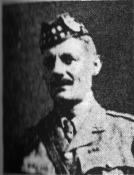
|
The King's School Canterbury |
Roll of Honour |
| Lieutenant Alexander Berowald INNES | |
|
1/7th (Deeside Highlanders) Battalion Gordon Highlanders Date of birth: 10th September 1872 Date of death: 18th June 1915 Killed in action aged 42 Buried at Le Touret Military Cemetery, Richebourg-L'Avoue Plot II Row D Grave 18 |

|
| He was born at Cowie House, Stonehaven in Kicardineshire on the 10th of September 1872 the eldest son of Lieutenant Colonel Alexander Innes JP DL of Raemoir, Cowie and Dunnottar, East Kent Regiment, and Helen Eythan (nee King). He was educated at the King's School Canterbury from May 1886 to July 1888 and at Glenalmond School from September 1988 until Easter 1891. On leaving school he studied practical engineering. He then spent five years as an engineer in charge of the Caledonian Engineering sheds at Aidrie and afterwards at Perth. He succeeded to the estates of Raemoir and Dunnottar in 1900, became a JP and became Deputy Lieutenant for the County of Kincardineshire on the 5th of November 1907. He also served as a County Councillor and as a member of His Majesty's Body Guard of Archers. He was married to Mary (nee Beveridge) at Dunfermline on the 1st of December 1910 and they lived at 6, Comely Park, Dunfermline. He served in the South African War from 1901 to 1902 with the Scottish Horse and received the King's Medal and the Queen's Medal with three clasps. Following the outbreak of war he was commissioned as a Lieutenant in the 1/7th Gordon Highlanders on the 10th of October 1914. He embarked for France with his battalion from Folkestone on board HMT "Onward" at 1am on the 3rd of May 1915 and disembarked at Boulogne at 3am. At 4pm on the afternoon of the 16th of June 1915 the 1/7th Battalion Gordon Highlanders arrived at Le Touret where they were placed under the command of 154th Brigade. At 9.20pm that night they received orders to advance to the reserve trenches and, on their arrival there at 11.05pm, they were ordered to occupy the firing line from the 7th Battalion Black Watch who had suffered heavy casualties during the day. They completed the relief by 2.35am the following morning. They came under shell fire throughout the 17th of June and at 7.30pm they were ordered to provide men in support of an attack by the 2nd Battalion Gordon Highlanders which was to be made at 9.30pm. D Company was ordered to make the attack and at 9.45pm they crept forward on the left of the 2nd Gordons. As they approached the enemy barbed wire the Germans spotted the men of the 2nd Gordons who were the first to arrive at the enemy wire. They immediately came under heavy rifle and machine gun fire and could advance no further. Captain Braid, the commanding officer of D Company, decided at 12.30am that with daylight due at 2am he should retire as his men could serve no useful purpose by remaining where they were. He had lost three men killed and seven wounded during the aborted attack. Throughout the rest of the 18th of June 1915 the enemy pounded the British first line causing the parapet to be blown in on several occasions. By the end of the day the enemy artillery had claimed the lives of Alexander Innes and eleven other ranks and had wounded a further four officers and twenty five other ranks. |
|
Back